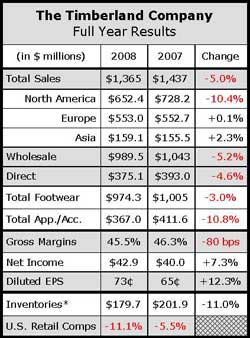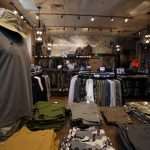The Timberland Co. again reported disappointing revenues for its fourth quarter, concluding the year in “a very challenging retail environment reflecting a downturn in consumer spending and global economic uncertainty.” Still, despite this uncertainty, the company said it remains firm with its goals for the upcoming fiscal year, but has developed a number of contingency operating plans to react to external factors that impact the business.
Fourth quarter sales declined 11.8% to $390.6 million. Earnings dropped 24.6% to $13.1 million, or 23 cents a share, from $24.1 million, or 40 cents, a year ago.

The company said the sales decline reflected the net closure of 28 retail stores globally, the transition to a licensing model for the companys North American apparel business and declines in its global Timberland branded footwear and international apparel businesses, partially offset by continued growth in SmartWool and Timberland PRO. Foreign exchange rate changes decreased fourth quarter 2008 revenue by approximately $14 million, or 3.1%, due to the strengthening of the U.S. dollar.
North America revenue declined 13.4% to $230.6 million, reflecting soft consumer spending in the U.S. region. Management said anticipated declines in Timberland-branded apparel and declines in women's boots and casual business offset strong growth in SmartWool and PRO.
North America retail revenues were down 17%, reflecting eight fewer doors and a 16% decline in comp store sales.
Europe revenue decreased 13.8% to $109.6 million but was relatively flat on a constant dollar basis. European results reflect declines in the casual footwear and apparel businesses, partially offset by strong sales of mens boots. Management intimated that the strengthening U.S. dollar “masked strong growth in certain markets, primarily Italy and Spain.”
Asia revenue increased 2.3% to $50.4 million, but decreased 7.0% on a constant dollar basis, driven primarily by declines in the apparel business and softness in the owned-retail business and declines throughout much of the region. Retail sales in Asia declined 5% as the benefit of changes in foreign exchange rates did not offset a 1% decline in comp store sales and the impact closing certain underperforming retail locations.
Global footwear revenue decreased 7.6% to $281.2 million due to declines in the casual footwear and womans boots businesses, which offset strength in the mens boots business in the European and Asian markets and strength in Timberland PRO series footwear. Apparel and accessories revenue decreased 22.2% to $103.8 million, due in part to anticipated declines in Timberland brand apparel as a result of the companys transition to a licensing model for its North American apparel business.
Global wholesale revenue decreased 10.9% to $257.3 million. Worldwide consumer direct revenue decreased 13.4% to $133.4 million, reflecting a difficult worldwide retail environment, revenue declines associated with the companys decision to close certain underperforming retail locations and the impact of foreign currency translation.
Operating income for the fourth quarter of 2008 was $23.1 million, compared to $32.4 million in the prior year period. The 2008 fourth quarter included approximately $2.6 million related to a favorable legal settlement, a $1.9 million non-cash intangible asset impairment charge and severance costs of approximately $2.3 million related to the companys ongoing initiatives to streamline its operations and rationalize its cost structure.
In the quarter, foreign exchange rate changes decreased operating income by approximately $5 million due to the strengthening of the U.S. dollar. Operating income in Q4 2007 included the reversal of approximately $8 million in accruals, primarily related to incentive compensation as its annual performance fell below minimum requirements.
Timberland ended the last quarter with $217.2 million in cash and no debt. Accounts receivable decreased 10.3% to $168.7 million, compared to the prior year.
TBL anticipates that 2009 will continue to be challenging due to uncertainty around consumer spending patterns and the financial health of the retail industry in general, conditions that make forecasting difficult. Given the volatile nature of current economic conditions, Timberland said it believes there is not sufficient visibility to set expectations for the performance of the business at this time.
In order to prepare for the rough year ahead, CFO, CAO and VP John Crimmins stated that the company will continue to invest in its plans for retail expansion, but the pace will be slowed “until macro factors improve.”















